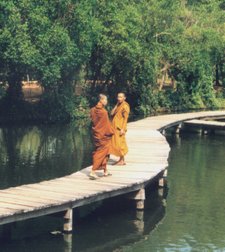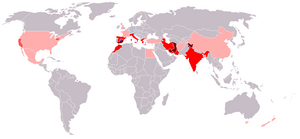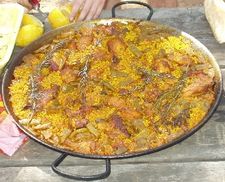Trade and usage of saffron
2007 Schools Wikipedia Selection. Related subjects: Plants

The trade and usage of saffron reaches back more than 3,000 years and includes marketing for medicinal, culinary, and colourative applications. Saffron, a spice derived from the dried stigmas of the saffron crocus (Crocus sativus), has remained among history's most costly comestibles. With its bitter taste, hay-like fragrance, and slight metallic notes, saffron has been used as a seasoning, fragrance, dye, and medicine. Saffron is native to Southwest Asia, but was first cultivated in Greece.
In both antiquity and modern times, most saffron was and is used in the preparation of food and drink: cultures spread across Africa, Asia, Europe, and the Americas value the red threads for use in such items as baked goods, curries, and liquor. Medicinally, saffron was used in ancient times to cure a wide range of ailments, including stomach upsets, bubonic plague, and smallpox; in modern times clinical trials have shown saffron's potential as an anticancer and anti-aging agent. Lastly, saffron has been used to colour textiles and other items, many of which carry a religious or hierarchical significance.
Saffron cultivation — as in ancient times — predominantly centres on a broad belt of Eurasia bounded by the Mediterranean Sea in the south-west to Kashmir and China in the north-east. Thus, the major saffron producers of antiquity — Iran, Spain, India, and Greece — continue to dominate the world trade. In recent decades cultivation has also spread to New Zealand, Tasmania, and California.
Modern trade
| World saffron cultivation patterns | |
|
|
|
| — Major growing regions. | |
| — Major producing nations. | |
| — Minor growing regions. | |
| — Minor producing nations. | |
| — Major trading centers (current). | |
| — Major trading centers (historical). | |
Virtually all saffron is produced in a wide geographical belt extending from the Mediterranean in the west to Kashmir in the east. All continents outside this zone — except Antarctica — produce smaller amounts. Annual worldwide production amounts to some 300 tonnes, including whole threads and powder. This includes 50 tonnes of annual production of top-grade "coupe" saffron in 1991. Iran, Spain, India, Greece, Azerbaijan, Morocco, and Italy (in decreasing order of production) dominate the world saffron harvest, with Iran and Spain alone producing 80% of the world crop. According to one source, Iran accounts for 96% of world production. Despite numerous cultivation efforts in such countries as Austria, England, Germany, and Switzerland, only select locales continue the harvest in Northern and Central Europe. Among these is the small Swiss village of Mund, in the Valais canton, whose annual saffron output comes to several kilograms. Micro-scale cultivation also occurs in Australia (in Tasmania), China, Egypt, France, Israel, Mexico, New Zealand, Turkey (particularly in the region surrounding Safranbolu, a city that took its name from saffron), the United States (especially in California and disproportionately by Iranian Americans) and Central Africa.
The high cost of saffron is due to the difficulty of manually extracting large numbers of minute stigmas; the only part of the crocus with the desired properties of aroma and flavour. In addition, a large number of flowers need to be processed in order to yield marketable amounts of saffron. A pound of dry saffron (0.45 kg) requires the harvesting of some 50,000 flowers, the equivalent of a football field's area of cultivation. By another estimate some 75,000 flowers are needed to produce one pound of dry saffron. This too depends on the average size of each saffron cultivar's stigmas. Another complication arises in the flowers' simultaneous and transient blooming. Since some 150,000 crocus flowers are needed to produce just one kg of dry saffron, about forty hours of intense labour, harvesting is often a frenetic affair. In Kashmir, for example, the thousands of growers must work continuously in relays over the span of one or two weeks throughout both day and night.
After they are extracted, the stigmas must be dried quickly, lest decomposition or mould ruin the batch's marketability. The traditional method of drying involves spreading the fresh stigmas over screens of fine mesh, which are then baked over hot coals or wood or in oven-heated rooms with temperatures reaching 30–35 °C for 10–12 hours. Afterwards, the dried spice is preferably sealed in airtight glass containers. Bulk quantities of relatively lower-grade saffron can reach upwards of US$500/pound, while retail costs for small amounts may exceed 10 times that rate. In Western countries the average retail price is approximately $1,000 per pound, however. The high price is somewhat offset by the small quantities needed: a few grams at most in medicinal use and a few strands per person in culinary applications; there are between 70,000 and 200,000 strands in a pound.
Experienced saffron buyers often have rules of thumb when deliberating on their purchases. They may look for threads exhibiting a vivid crimson colouring, slight moistness, and elasticity. Meanwhile, they reject threads displaying telltale dull brick red colouring (indicative of age) and broken-off debris collected at the container's bottom (indicative of age-related brittle dryness). Such aged samples are most likely encountered around the main June harvest season, when retailers attempt to clear out the previous season's old inventory and make room for the new season’s crop. Indeed, experienced buyers recommend that only the current season's threads should be used at all. Thus, reputable saffron wholesalers and retailers will indicate the year of harvest or the two years that bracket the harvest date; a late 2002 harvest would be shown as "2002/2003".
Culinary use
Saffron is used extensively in Arab, Central Asian, European, Indian, Iranian, and Moroccan cuisines. Its aroma is described by cooking experts and saffronologists as resembling that of honey, with grassy, hay-like, and metallic notes. Saffron's taste is like that of hay, but with hints of bitterness. Saffron also contributes a luminous yellow-orange colouring to items it is soaked with. For these traits saffron is used in baked goods, cheeses, confectionaries, curries, liquors, meat dishes, and soups. Saffron is used in India, Iran, Spain, and other countries as a condiment for rice. In the cuisine of Spain, it is used in many famous dishes such as paella valenciana, which is a spicy rice-meat preparation, and the zarvela fish stews. It is also used in fabada asturiana. Elsewhere, saffron is needed in the French bouillabaisse, which is a spicy fish stew from Marseilles, the Italian risotto alla milanese and the Cornish Saffron Cake.
Iranians use saffron in their national dish, chelow kabab, while Uzbeks use it in a special rice dish known as a "wedding plov" (cf. pilaf). Moroccans use it in their tajine-prepared dishes, including kefta ( meatballs with tomato) , mqualli (a citron-chicken dish), and mrouzia (succulent lamb dressed with plums and almonds). Saffron is also central in chermoula herb mixture, which flavours many Moroccan dishes. Indian cuisine uses saffron in its biryanis, which are spicy rice-vegetable dishes. (An example is the Pakki variety of Hyderabadi biryani.) It is also used in Indian milk-based sweets such as gulab jamun, kulfi, double ka meetha, and "saffron lassi", which is a spicy Jodhpuri yogurt-based drink.
Because of its high cost, saffron was often replaced by or diluted with safflower (Carthamus tinctorius) or turmeric (Curcuma longa) in cuisine. Both mimic saffron's colour well, but have flavours very different from that of saffron. Saffron is also used in the confectionery and liquor industries; this is its most common use in Italy. Chartreuse, gin, izarra, and strega are types of alcoholic beverages that rely on saffron to provide a flourish of colour and flavour.
Experienced saffron users often crumble and pre-soak threads for several minutes prior to adding them to their dishes. For example, they may toss threads into water or sherry and leave them to soak for approximately ten minutes. This process extracts the threads' colour and flavour into the liquid phase; powdered saffron does not require this step. Afterward, the soaking solution is added to the hot and cooking dish. This allows even distribution of saffron's colour and flavour throughout a dish, and is important when preparing baked goods or thick sauces.
Medicinal use
Saffron's traditional folkloric uses as an herbal medicine are legion. It has been used for its carminative and emmenagogic properties, for example. Medieval Europeans used saffron to treat respiratory infections and disorders such as coughs and common colds, scarlet fever, smallpox, cancer, hypoxia, and asthma. Other targets included blood disorders, insomnia, paralysis, heart diseases, flatulence, stomach upsets and disorders, gout, chronic uterine haemorrhage, dysmorrhea, amenorrhea (absence of menstrual period), baby colic, and eye disorders. For ancient Persians and Egyptians, saffron was also an aphrodisiac, a general-use antidote against poisoning, a digestive stimulant, and a tonic for dysentery and measles. In Europe practitioners of the archaic "Doctrine of Signatures" took saffron's yellowish hue as a sign of its supposed curative properties against jaundice.
Saffron's carotenoids have been shown in scientific studies to have anticarcinogenic (cancer-suppressing), anti-mutagenic (mutation-preventing), and immuno-modulating properties. The active ingredient behind these effects has been identified as dimethyl-crocetin. This compound counters a wide spectrum of both murine (rodent) tumours as well as human leukaemia cancer cell lines. Saffron extract also delays ascites tumour growth, delays papilloma carcinogenesis, inhibited squamous cell carcinoma, and decreases the incidence of soft tissue sarcoma in treated mice. Researchers theorise that such anticancer activity can be best attributed to dimethyl-crocetin's disruption of the DNA-binding ability of proteins, as shown in Thymidine-uptake studies. Specifically, the DNA-binding ability of enzymes known as type II topoisomerases within cancer cells is inhibited. Thus, the malignant cells are unable to synthesize or replicate their own DNA.
Saffron's pharmacological effects on malignant tumours have been documented in studies done both in vitro and in vivo. For example, saffron extends the lives of mice that are intraperitoneally impregnated with transplanted sarcomas, namely, samples of S-180, Dalton's lymphoma ascites (DLA), and Ehrlich ascites carcinoma (EAC) tumours. Researchers followed this by orally administering 200 mg of saffron extract per each kg of mouse body weight. As a result the life spans of the tumour-bearing mice were extended to 111.0%, 83.5%, and 112.5%, respectively, in relation to baseline spans. Researchers also discovered that saffron extract exhibits cytotoxicity in relation to DLA, EAC, P38B, and S-180 tumour cell lines cultured in vitro. Thus, saffron has shown promise as a new and alternative treatment for a variety of cancers.
Besides wound-healing and anticancer properties, saffron is also an antioxidant. This means that, as an "anti-aging" agent, it neutralises free radicals. Specifically, methanol extractions of saffron neutralise at high rates the DPPH ( IUPAC nomenclature: 1,1-diphenyl-2-picrylhydrazyl) radicals. This occurred via vigorous proton donation to DPPH by two of saffron's active agents, safranal and crocin. Thus, at concentrations of 500 and 1000 ppm, crocin studies showed neutralisation of 50% and 65% of radicals, respectively. Safranal displayed a lesser rate of radical neutralisation than crocin, however. Such properties give saffron extracts promise as an ingredient for use as an antioxidant in pharmaceuticals, cosmetics, and as a food supplement. Ingested at high enough doses, however, saffron is lethal. Several studies done on lab animals have shown that saffron's LD50 (semi-lethal dose, or the dose at which 50% of test animals die from overdose) is 20.7 g/ kg when delivered via a decoction.
Colouring and perfumery
| Saffron | ||
|---|---|---|
| — Colour coordinates — | ||
| Hex triplet | #F4C430 | |
| RGBN | ( r, g, b) | (244, 196, 48) |
| CMYKN | ( c, m, y, b) | (10, 58, 206, 10) |
| HSV | ( h, s, v) | (45°, 80%, 96%) |
| N : Normalised to [0–255]. | ||
Despite its high cost, saffron has also been used as a fabric dye, particularly in China and India. Nevertheless, it is an unstable colouring agent; the initially vibrant orange-yellow that it imparts on clothes quickly fades to a pale and creamy yellow. The saffron stigmas, even when used in minute quantities, produce a luminous yellow-orange colour. Increasing the amount of saffron applied will turn the fabric's imparted colour an increasingly rich shade of red. Traditionally, the noble classes were the exclusive users of saffron-dyed clothes. Saffron was thus accorded a ritualised and caste-representative significance. Saffron dye also has been responsible for the saffron, vermilion, and ochre hues of the distinctive mantles and robes worn by Hindu and Buddhist monks. Meanwhile, in medieval Europe well-to-do Irish and Highland Scots would wear a long linen undershirt known as a léine; this garment was traditionally dyed with saffron.
There have been many attempts to replace costly saffron with a cheaper dye. Saffron's usual substitutes in food — turmeric, safflower, and other spices — yield a bright yellowish hue that does not match that of saffron exactly. Nevertheless, saffron's main colour-yielding constituent, the flavonoid crocin, has been discovered in the gardenia fruit. Because gardenia is much less expensive to cultivate than saffron, it is currently being researched in China as an economical saffron-dye substitute.
Saffron has also been used for its aromatic properties alone. In Europe, for instance, saffron threads were processed and combined with such ingredients as alkanet, dragon's blood (for colour), and wine (for colour) to produce an aromatic oil known then as crocinum. Crocinum was then applied as a perfume to hair. Another preparation involved the mixing of saffron with wine to produce a viscous yellow spray that was copiously applied to freshen the air of Roman theatres.
Citations
|

Buddhist clergy, such as these monks in Thailand, often donned saffron-hued robes. Traditionally, these were coloured using saffron-based dyes.
|




